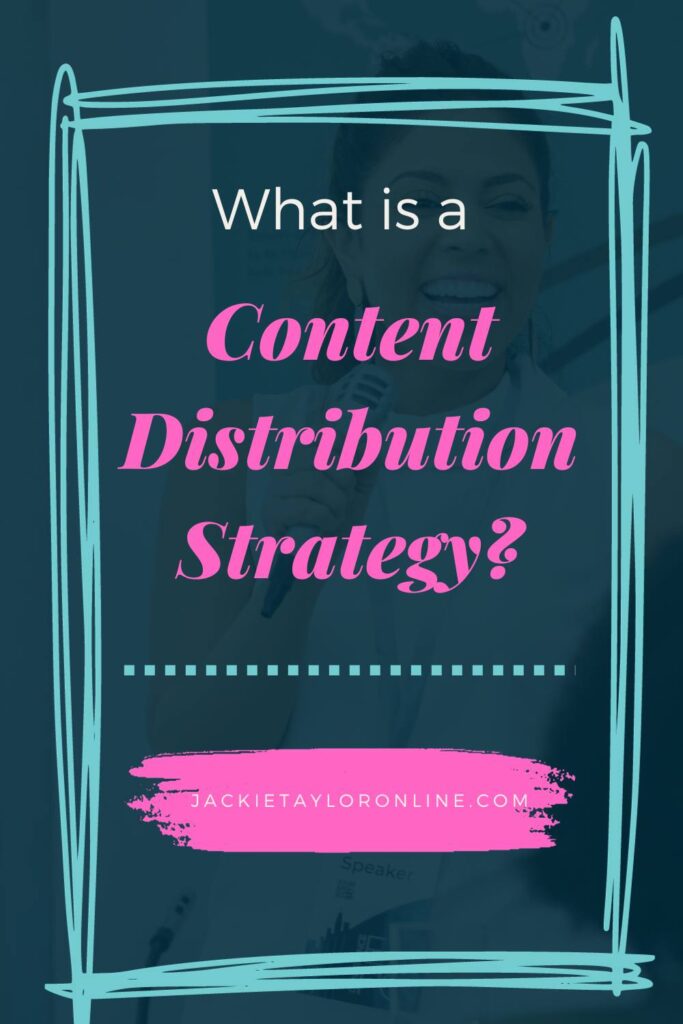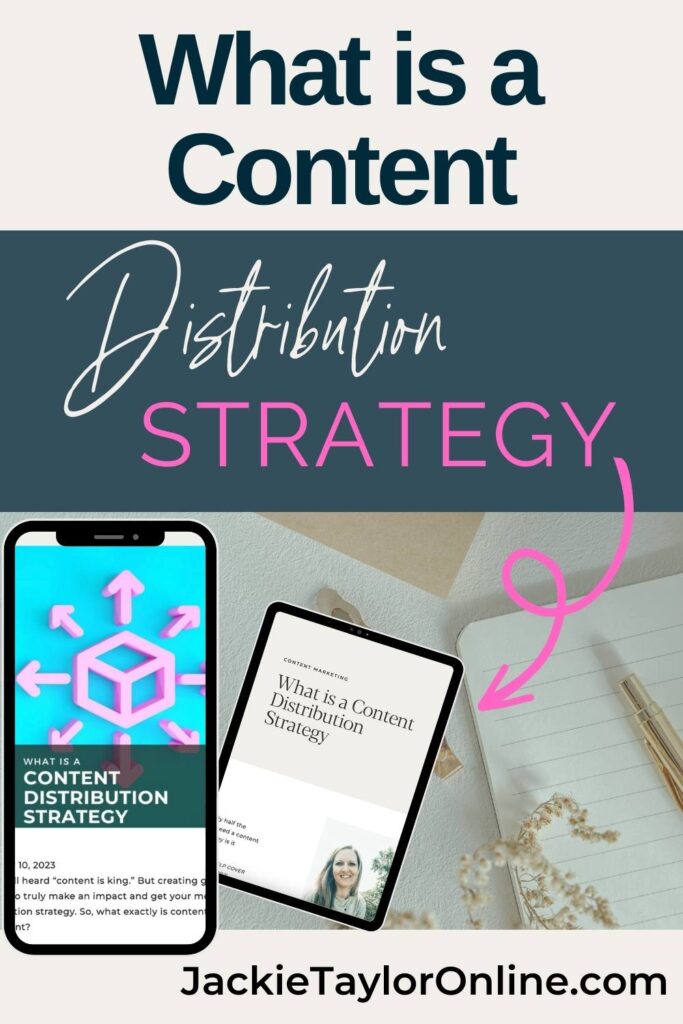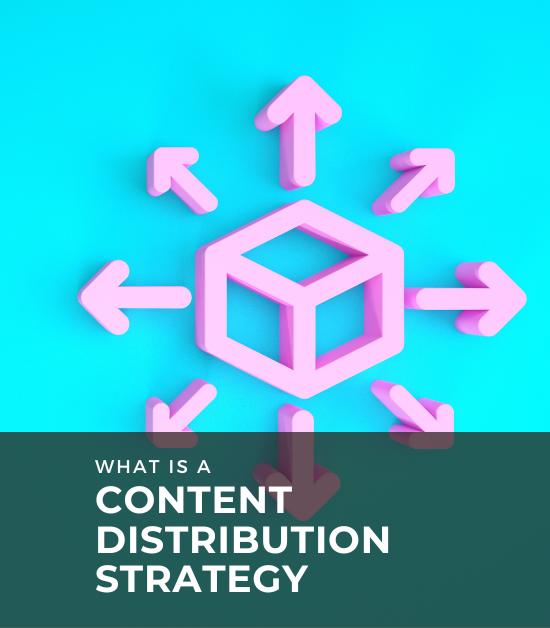So what is content creation and distribution? We’ve all heard “content is king.” But creating great content is only half the battle. To truly make an impact and get your message heard, you need a content creation and distribution strategy. So, what exactly is content creation? And how do you create a content distribution strategy? But really, why is it important?
AFFILIATE DISCLAIMER: I SOMETIMES LINK TO PRODUCTS AND SERVICES TO HELP COVER THE COSTS OF RUNNING THIS BLOG. THERE’S NO EXTRA COST TO YOU – AND I ONLY RECOMMEND PRODUCTS THAT I’VE BOTH USED PERSONALLY AND THINK ARE QUALITY PRODUCTS THAT HELP WITH EFFICIENCY. PLEASE READ MY AFFILIATE DISCLOSURE FOR MORE INFORMATION. THANKS FOR YOUR SUPPORT!
Table of Contents
- What is a content creation and distribution strategy?
- Types of Content Creation and Distribution Channels
- What are Some Content Creation and Distribution Platforms
- How to create a content creation and distribution strategy
- Tips for Making the Most of Your Content Creation and Distribution Strategy
- Content Creation and Distribution Strategy
Share it on Pinterest!

What is a content creation and distribution strategy?
Content distribution refers to the various methods and channels used to promote and share your content with your target audience. It involves reaching out to different platforms and avenues to ensure your content gets maximum exposure and engagement.
When it comes to content distribution, there are numerous strategies and techniques that can be employed.
A few types of content distribution include social media, email marketing, influencer marketing, and many more. We’ll go into these different types in more detail below.
The main thing to remember about content distribution is that it’s important to tailor your content for each platform to maximize its impact and engagement.
That means you create content with your main platform in mind, first and foremost. But also think about those channels or platforms that you’ll repurpose your content to. What type of content does best on those platforms? What are the little nuances of that platform?
Every online platform (blogs, social media, video) they all have their own little community. And they all do things their own way. You can’t go on TikTok and create the same exact video that you use on Instagram and expect the same results. TikTok and Instagram have different audiences. People interact with content differently on each online platform.
For example, let’s say your main platform that you create for is a blog. Create your content for your blog, but in the back of your mind start thinking about how this blog post will be repurposed. Think about what channels you’ll repurpose to, so you can create with those channels in mind.
According to Contentoo, creating a content creation and distribution strategy “ensures your content is aligned with your audiences’ media consumption preferences. As a result, you improve the visibility of your content and drive engagement, which helps you achieve a better ROI. For best results, use a mix of owned, earned and paid content.”
We talk more about owned, earned, and paid content channels below.
Related Article: 40+ Online Marketing Resources: You Don’t Want to Miss
Types of Content Creation and Distribution Channels
When it comes to content distribution, there are different types of channels you can leverage. These channels can be categorized into owned, earned, and paid.
Owned Content Channels
What are owned channels? They’re platforms or channels that you have control over what content is posted.
Owned Content channels include:
- Your website
- Blog
- Social media profiles
- Podcast
- YouTube
These channels are a great starting point for distributing your content as they allow you to engage with your existing audience and build your brand.
Having your own website gives you the freedom to create and publish content that aligns with your brand’s values and goals. You can design your website to reflect your brand’s unique identity, and optimize it for search engines to attract organic traffic.
With a blog, you can regularly publish informative and engaging articles that provide value to your audience, positioning yourself as an industry expert.
Social media profiles are another powerful owned channel for content distribution. Platforms like TikTok, Twitter, Instagram, and Facebook allow you to share your content directly with your followers. You can create engaging posts, share updates about your products or services, and interact with your audience through comments and direct messages.
Related Article: Content Style Guide: 3-Step Guide for Your Business
Earned Content Channels
What are earned channels? They’re platforms where your audience shares or talks about your content.
Earned content channels include:
- Mentions and shares on social media
- Guest posts on other websites
- Reviews or recommendations from influencers
Earned channels help you reach a broader audience and increase your brand credibility.
When your audience shares or talks about your content on social media, it creates a ripple effect. Their followers see their posts and become interested in your content, leading to more exposure and potential engagement.
Guest posting on other websites allows you to tap into their existing audience and establish yourself as a thought leader in your industry. By providing valuable insights and expertise, you can attract new readers and potentially convert them into loyal followers.
Reviews and recommendations from influencers can significantly impact your brand’s visibility and reputation. When influencers endorse your content, their followers are more likely to trust and engage with it. This can lead to increased traffic to your owned channels and potentially generate new leads or customers.
Related Article: The Buyers Journey: How to Create Content That Guides Your Audience to Purchase
Paid Content Channels
What do Paid channels involve? It’s all about investing money to promote your content.
Paid content channels include:
- Social media advertising
- Search engine marketing
- Sponsored content placements
- Affiliate marketing
- Influencer collaborations or UGC (User Generated Content)
Paid channels can help you reach a targeted audience and accelerate your reach and engagement.
Social media advertising allows you to create targeted campaigns to reach specific demographics or interests. By leveraging the targeting options provided by platforms like Facebook Ads or Instagram Ads, you can ensure that your content is seen by the right people who are more likely to be interested in what you have to offer.
Search engine marketing involves bidding on keywords to have your content appear in search engine results. This can be an effective way to reach users who are actively searching for information related to your industry or products.
Affiliate marketing gets a bad name from all the TikTok videos and reels promoting it as a get rich quick scheme. But in truth affiliate marketing isn’t all bad, and it’s actually been around for a very long time. It’s providing incentive to those who have purchased from you in the past and want to share your product or service with their followers.
Sponsored content placements allow you to collaborate with other websites or influencers to promote your content. This can involve paying for sponsored blog posts, videos, or social media mentions. Even partnering with influencers or UGC (User Generated Content) creators.
Leveraging different types of content distribution channels is crucial for reaching a wider audience and increasing brand visibility.
- Owned channels provide you with control and the opportunity to engage with your existing audience.
- Earned channels help you tap into new audiences and build credibility.
- Paid channels allow you to accelerate your reach and target specific demographics.
By utilizing a combination of these three channels, you can maximize the impact of your content and achieve your marketing goals.
What are Some Content Creation and Distribution Platforms
Now that you understand the different types of channels, let’s take a look at some specific content distribution platforms you can leverage:
Social media
Social media platforms like TikTok, Facebook, Instagram, Twitter, Pinterest, YouTube, and LinkedIn are popular channels for distributing content. They allow you to reach a wide audience and engage with your followers through posts, stories, and live videos, pins, images, and more.
Email marketing
Email marketing is a powerful tool for distributing content directly to your audience’s inbox. By building an email list and sending regular newsletters, you can drive traffic to your website. And you’ll keep your audience updated on your latest content, including affiliate partnerships. That adds a passive income stream for your business.
Content syndication platforms
Content syndication platforms like Medium, LinkedIn Pulse, and Quora are great for republishing your content and reaching new audiences. They allow you to tap into their user base and expose your content to a wider network.
Influencer partnerships
Collaborating with influencers in your industry can give your content a boost. By partnering with influencers, you can tap into their existing audience and benefit from their credibility and reach.
Blogging
Blogging is a great content distribution platform because it gives you long-term results. Maybe you’ve heard people say blog content has a longer shelf life? That just means once you hit publish on a blog, it can bring traffic to your website. And this can happen long after you’ve created it.
Blogging can do this because it is setup to give you a more optimized website using search engine optimization techniques. This means you’re using keywords throughout your blog posts, so search engines like Google will find your content. By optimizing your content with keywords, you’re making it so you can get in front of your ideal audience. And you’re doing so right when they’re searching for what you sell.
It’s meeting your audience where they are. And where they need to find you during the buying process to make an informed decision and purchase.
Related Article: The Buyers Journey: How to Create Content That Guides Your Audience to Purchase
How to create a content creation and distribution strategy
Now that you have an understanding of content distribution and the different platforms you can leverage, let’s dive into how you can create an effective content creation and distribution strategy:
1. Define your goals and target audience
Before getting started, it’s important to clearly define your goals and identify your target audience. What do you want to achieve with your content distribution efforts, and who are you trying to reach?
When you understand your goals and target audience, you’re tailoring your content creation and distribution strategy. And you’re effectively reaching and engaging with the right people.
2. Create high-quality content
The foundation of any successful content creation and distribution strategy is high-quality content. Create valuable and engaging content that resonates with your target audience. This will increase the chances of your content being shared and distributed organically.
Related Article: Master Pillar Content: How to Pick Your Pillars with Examples
3. Identify the right distribution channels
Based on your goals and target audience, identify the distribution channels that will work best for your content. This could include social media platforms, email marketing, content syndication platforms, or influencer partnerships.
Focus on channels that align with your brand and have a high potential to reach your target audience.
4. Optimize your content for distribution
When creating your content, ensure it is optimized for distribution. This includes using relevant keywords, adding share buttons, and creating visually appealing assets like images and videos.
The easier it is for people to share and consume your content, the more likely it is to get distributed and reach a wider audience.
Related Article: The Ultimate SEO Guide
5. Develop a promotion plan
Don’t just rely on organic distribution. Develop a promotion plan to actively promote your content through paid channels and collaborations. Set aside a budget for advertising and explore opportunities for partnerships with influencers or other brands.
Pin it on Pinterest!

Tips for Making the Most of Your Content Creation and Distribution Strategy
Here are some additional tips to help you make the most of your content creation and distribution strategy:
1. Monitor and analyze your results
Regularly monitor and analyze the performance of your content distribution efforts. Look at metrics like reach, engagement, and conversions to identify what’s working and what needs improvement.
2. Experiment and iterate
Don’t be afraid to experiment and try new distribution channels or strategies. As the digital landscape evolves, so should your content creation and distribution strategy. Stay open to new ideas and iterate based on what works best for your audience.
And remember, you don’t have to be everywhere and have an omni-channel presence online. Find the channel or just a few channels, that work for you and stay consistent with a posting schedule that fits your lifestyle.
And ALWAYS create your content strategy specifically for you business, not the online platform that you want to be on. Because plans change. You don’t wanted to be permanently tied to one platform.
3. Foster relationships with your audience
Engage with your audience by responding to comments and messages. Foster relationships with your audience to build trust and loyalty. This will encourage them to share your content and become advocates for your brand.
Engagement on social media, blogs, YouTube and more doesn’t just mean responding to comments on your own content. It also means interacting with other creators in your industry or similar areas to your own business.
Related Article: The Buyers Journey: How to Create Content That Guides Your Audience to Purchase
4. Repurpose and republish your content
Maximize the reach of your content by repurposing and republishing it across different platforms. Turn blog posts into videos, infographics, or podcasts. Republish your content on relevant platforms to reach new audiences.
On the flip side, take short-form content like reels and turn them into longer videos for YouTube. Take a collection of reels and create a blog post or a podcast.
Related Article: How to Develop An Effective Content Distribution Strategy
Content Creation and Distribution Strategy
A content creation and distribution strategy is essential for ensuring your content gets the reach and engagement it deserves. By leveraging different distribution channels and platforms, you can amplify your message and drive traffic to your website.
Remember to define your goals, create high-quality content, optimize for distribution, and actively promote your content. Monitor and analyze your results, experiment and iterate, foster relationships with your audience, and repurpose your content to maximize its reach.
With a well-executed content creation and distribution strategy, you can establish your brand as a thought leader. You’ll connect with your target audience better.

+ show Comments
- Hide Comments
add a comment